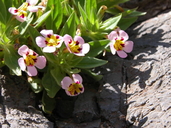Taxon Details
Diplacus rupicola
Death Valley monkeyflower
View Report Copy Link Calflora eFlora CCH CalPhotos iNaturalist
Taxon Summary:
Diplacus rupicola, commonly known as Death Valley monkeyflower, is a perennial herb in the Phrymaceae that is found only in California. It occurs within Mojavean desert scrub (carbonate, and rocky), growing at elevations from 300 to 1830 meters. Diplacus rupicola is ranked 4.3, Plants of Limited Distribution, A Watch List; Not very threatened in California.|
Scientific Name: Diplacus rupicola (Coville & A.L. Grant) G.L. Nesom & N.S. Fraga |
||
|
Common Name: Death Valley monkeyflower |
||
| Family: | Phrymaceae | |
| Element Code: | PDSCR1B2H0 | |
| USDA Plants Symbol: | ||
|
Synonyms/Other Names: |
||
| Name Status: |
JEF, FNA, POWO, IPNI, Tropicos |
|
| CA Rare Plant Rank: | 4.3 |
| Fed List: | None |
| State List: | None |
| Global Rank: | G4 |
|
State Rank: |
S4 |
| Other Status: | SB_CalBG/RSABG |
|
CRPR Changes: |
|
| Add Date: | 1974-01-01 |
| Date Edited: | 2025-10-29 |
| Lifeform: perennial herb | ||||||||||||||
Blooming Period: Feb-Jun
|
||||||||||||||
|
Elevation:
300 - 1830 meters 985 - 6005 feet |
||||||||||||||
General Habitats:
|
||||||||||||||
| Microhabitat Details: | ||||||||||||||
|
Microhabitat:
|
||||||||||||||
| Threat List Total: | 0 | |
| Total EOs | % of EOs | |
| EOs with Threat Listed: | 0 | 0 % |
| THREAT LIST: | ||
|---|---|---|
| Total Occurrences: | 0 | ||||
| Element Occurrence Ranks: | |||||
|---|---|---|---|---|---|
| A | B | C | D | X | U |
| 0 | 0 | 0 | 0 | 0 | 0 |
| Occurrence Status: | |||||
|---|---|---|---|---|---|
| Historical >20 Years | 0 | ||||
| Recent <=20 Years | 0 | ||||
| Presence: | |||||
|---|---|---|---|---|---|
| Presumed Extant | 0 | ||||
| Possibly Extirpated | 0 | ||||
| Presumed Extirpated | 0 | ||||
| California Endemic: | |||||||||||||
| California Island: | |||||||||||||
|
States: Name (Code) California (CA) |
|||||||||||||
|
California Counties and Islands: Name (Code) Inyo (INY), Kern (KRN) |
|||||||||||||
|
Quads: Name (Quad Code) Beatty Junction (3611658), Chloride City (3611668), Copper Queen Canyon (3511772), Cottonwood Canyon (3611753), Devils Speedway (3611638), East of Sand Flat (3611763), Echo Canyon (3611646), Fall Canyon (3611772), Furnace Creek (3611647), Grapevine (3411888), Hanging Rock Canyon (3711726), Last Chance Mtn. (3711736), Last Chance Range SE (3711715), Last Chance Range SW (3711716), Maturango Peak (3611714), Nevares Peak (3611657), Panamint Springs (3611734), Sand Spring (3711725), Thimble Peak (3611771), Ubehebe Crater (3711714), Ubehebe Peak (3611765), Wildrose Peak (3611731) |
|||||||||||||
Notes:
|
|||||||||||||
 Presumed Extant
Presumed Extant
Click on quad for name. Hold Shift Key to use mouse scroll wheel



